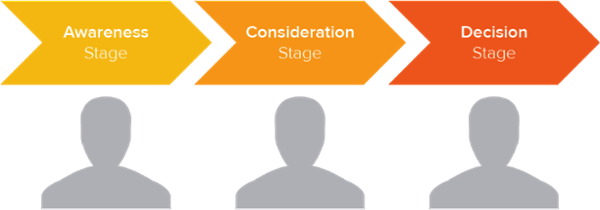Digital customer focus with Maslow's pyramid
Even in B2B, you want to have a sharp focus on the customer. This starts with fulfilling certain customer needs. But in this digital age, it is harder than ever to determine what your (future) customer needs.
Even in B2B, you want to have a sharp focus on the customer. This starts with fulfilling certain customer needs. But in this digital age, determining what your (future) customer needs is harder than ever! Marketing rules have been rewritten since the advent of the Internet. But have people's - and therefore your customers' - needs changed since then? In an attempt to answer that question, I took Maslow's famous pyramid of needs off the shelf and put it in a digital jacket.
We are all familiar with Maslow's pyramid, which schematically depicts the needs of each individual. Only when one level is achieved can one move to the next level. In marketing, the pyramid is still used to explain and respond to the needs of consumers.
Traditionally, the consumer market (B2C) has never had much trouble addressing customer needs at the different levels of the pyramid. Take the safe and reliable Volvo family car that uses this to promise consumers the need "security" on the ladder, or Coca Cola's "Share a Coke" campaign that acts on the level "acceptance" (the need to belong to a group).
But even in B2B in the year 2015, we can still find new inspiration if we look at the pyramid (and adjust here and there). At each level, I therefore make the distinction between need (of the average B2B customer) and solution (for you as a marketer). Which steps should not be skipped and: how do you reach the highest level?
The first level of the pyramid are the primary needs.
1. Primary needs (basic level)
Need
A hot topic in B2B marketing is that business customers want to hear more than just "product talk. It's all about adding value these days. But read carefully: more than just product talk! Because; the more complex or valuable the product or service, the more decision makers and influencers are involved in the process. 'Dry' product information remains a primary need of the customer to weigh the pros and cons in order to make an informed decision.
These substantive questions about your product or service are relatively easy to answer. However, in today's digital landscape - where much of the buying process takes place online and the customer searches for this information independently - it is important to answer these questions in time and in the right place. 57% of the customer journey is completed before a potential customer talks to a salesperson!
Solution
So the key is to respond early to the buying process of your specific target groups. You do this by making your product information as accessible as possible. Find out which questions your target group will look for answers to online. These 'pain points' of your target group can often be translated into very concrete searches in Google. With a content strategy, you can work on your search engine ranking and meet the customer online.

2. Certainty (basic level)
Need
The customer's primary need (consciously or unconsciously) is a solution to his or her problem. This solution may come in the form of your product or service. But the B2B customer is looking for more. A good product or strong brand are no longer a differentiator, but have become hygiene factors.
Why does the customer choose you and not the competitor? What is your added value (and thus distinguishing capacity)? What security do you offer the customer? Saving money or time? Insight and overview? Safety? Health? A way of life? A better world?
Solution
The first step to no longer (only!) talk from the product is to think carefully about your own added value as an organization. Compared to your competitor, but also compared to the market (a disrupter is in a small corner). Good news: it's never too late for that!
Thought leader Simon Sinek described this simply and clearly in his book "Start with why". (Tip: watch this TED talk, it will save you time). The business customer is looking for a reliable partner that offers certainty in whatever form (or product, or service) they choose. Instead of a product, start offering that certainty and tailor your future marketing (content) strategy accordingly. In other words, start with why!
3. Acceptance
Need
If your organization can meet the basic levels (problem solving) and offer certainty (added value) you can really focus on the customer. If the first two basic levels do not exist then the customer will not get to the third level - acceptance. This level is called"love and belonging" in Maslow's original version. People naturally want to belong to a group, build a bond with others and be addressed personally.
Business to business, what does that really mean? Your business is not a building. Nor are you selling your product to a building. Your organization, as well as the customer's, consists of a group of motivated and passionate people. Your organization's sales department works every day to make (new) valuable connections between people - and thus organizations.
But this level - love and belonging - is not just the job of sales. Social media and other online channels are not there so you can send your advertising message out into the world and then wait for customers to come to you and wave money. I quote the statistic again: 57% of the customer journey is already complete before a potential customer talks to a salesperson. If you blindly send your messages out into the world(push) then you are missing out on 43% of great opportunities.
Solution
Start by knowing your target audience inside out: create buyer personas. Make sure you know what keeps your target group awake at night and where they are in the purchase process. Only then can you start to address them personally and set up your (social) channels to build future relationships. Engage in dialogue (even in the earliest stages of the buying process), solve problems and you will see: organization and relationship become one.

4. Recognition
Need
Respect from others, respect for oneself, status and responsibility are keywords at this level. The customer needs appreciation, recognition to be an individual. These needs can be linked to mutual respect in a group.
Solution
To turn a business customer into a loyal customer continue to put marketing and sales at the service of the customer even after the deal is closed. Keep working continuously on the needs and wants of your prospects as well as those of your customers. In short; work on customer centricity and marketing and sales alignment.

Source cartoons: https: //marketoonist.com/
Source header: Flickr
5. Self-development
Need
Every person has the need to develop himself or herself into a unique human being with a unique personality. What one does is must be of value to others. This is also what your B2B customer needs. With the advent of the Internet and social media, customers can work on their own self-development easier than ever. And so they do!
Solution
To reach the highest level, you will not only have to be a thought leader yourself, but also guide the customer in his path to thought leadership. You do this by contributing to the added value that the client offers to its customers. B2B companies acting at this level continuously work to enrich their customers and fulfill the role of coach.
Digital customer focus
Achieving true customer focus in this digital age requires a renewed understanding of your B2B customer's wants and needs. In essence, these needs remain the same as before the advent of the Internet. What is changing, however, is the way the customer moves online. If you have an understanding of your customer's needs, then you can start working on customer centricity at all levels.
And so, even years after the fact, Maslow has a lot to teach us.

Want to get the most out of HubSpot? Subscribe to our newsletter, follow us on LinkedIn, or attend our HubSpot User Days!
Explore HubSpot User DaysShare this
You May Also Like
These Related Stories

Customer journey mapping: make a difference during the customer journey

Many B2B companies miss important opportunities


